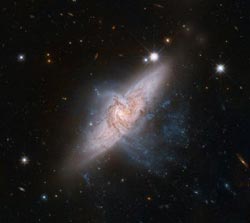Chance alignment between galaxies mimics a cosmic collision

The NASA/ESA Hubble Space Telescope has produced an incredibly detailed image of a pair of overlapping galaxies called NGC 3314. While the two galaxies look as if they are in the midst of a collision, this is in fact a trick of perspective: the two are in chance alignment from our vantage point. Credit: Credit: NASA, ESA, the Hubble Heritage Team (STScI/AURA)-ESA/Hubble Collaboration, and W. Keel (University of Alabama)<br>
The two galaxies look as if they are colliding, but they are actually separated by tens of millions of light-years, or about ten times the distance between our Milky Way and the neighboring Andromeda galaxy. The chance alignment of the two galaxies, as seen from Earth, gives a unique look at the silhouetted spiral arms in the closer face-on spiral, NGC 3314A.
The motion of the two galaxies indicates that they are both relatively undisturbed and that they are moving in markedly different directions. This indicates they are not on any collision course. NGC 3314A's warped shape is likely due to an encounter with another nearby galaxy, perhaps the large spiral galaxy NGC 3312 (located outside the Hubble image).
Because of the alignment, NGC 3314B's dust lanes appear lighter than those of NGC 3314A. This is not because that galaxy lacks dust, but rather because its dust lanes are lightened by the bright fog of stars in the foreground. NGC 3314A's dust, in contrast, is backlit by the stars of NGC 3314B, silhouetting them against the bright background.
The color composite was produced from exposures taken in blue and red light with Hubble's Advanced Camera for Surveys. The pair of galaxies lie roughly 140 million light-years from Earth, in the direction of the southern hemisphere constellation Hydra.
Credit: NASA, ESA, the Hubble Heritage Team (STScI/AURA)-ESA/Hubble Collaboration, and W. Keel (University of Alabama)
Media Contact
More Information:
http://www.stsci.eduAll latest news from the category: Physics and Astronomy
This area deals with the fundamental laws and building blocks of nature and how they interact, the properties and the behavior of matter, and research into space and time and their structures.
innovations-report provides in-depth reports and articles on subjects such as astrophysics, laser technologies, nuclear, quantum, particle and solid-state physics, nanotechnologies, planetary research and findings (Mars, Venus) and developments related to the Hubble Telescope.
Newest articles

Bringing bio-inspired robots to life
Nebraska researcher Eric Markvicka gets NSF CAREER Award to pursue manufacture of novel materials for soft robotics and stretchable electronics. Engineers are increasingly eager to develop robots that mimic the…

Bella moths use poison to attract mates
Scientists are closer to finding out how. Pyrrolizidine alkaloids are as bitter and toxic as they are hard to pronounce. They’re produced by several different types of plants and are…

AI tool creates ‘synthetic’ images of cells
…for enhanced microscopy analysis. Observing individual cells through microscopes can reveal a range of important cell biological phenomena that frequently play a role in human diseases, but the process of…





















